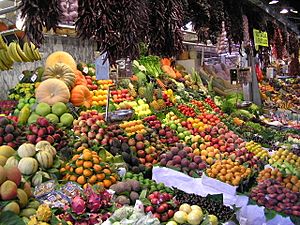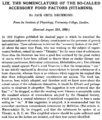Vitamin facts for kids
- A "vitamin" is also a pill that contains vitamins, eaten regularly to keep one healthy.
A vitamin is a chemical compound that is needed in small amounts for the human body to work correctly. They include Vitamin A, many B vitamins (like B1, B2, B3, B6, and B12), Vitamin C, Vitamin D, Vitamin E, and Vitamin K. For example, citrus fruits such as oranges and lemons contain vitamin C.
The term was coined in 1912 by biochemist Casimir Funk, who isolated a complex of micronutrients and proposed the complex be named vitamine. By convention the word vitamin does not include other essential nutrients, such as certain minerals, essential fatty acids and essential amino acids.
Thirteen vitamins are recognized at present. Vitamins are classified by their biological and chemical activity, and not their structure. Each vitamin name (the word vitamin followed by a letter) refers to a number of vitamer compounds which all show the same biological activity. For example, vitamin A refers to several different chemicals. Vitamers convert to the active form of the vitamin in the body. They are sometimes inter-convertible to one another as well.
The body does not make these chemicals. They come from other places, usually food. A short term lack of a certain vitamin is usually not a problem, because the body can store vitamins for a short time. Not having a certain vitamin for a longer period of time can lead to different diseases, depending on the vitamin. Probably the best-known of these diseases is scurvy, which results from not having enough Vitamin C. Beriberi and rickets are others.
Today, many drug companies make inexpensive pills that contain various vitamins. They help people avoid those diseases.
Vitamins can be either fat-soluble or water-soluble. Fat-soluble vitamins (A, D, E and K) can be stored in the body, and are used when needed. Water-soluble ones only stay in the body a short time.
Name changes
Currently there are no vitamins F to J. These existed at some time. Today they are no longer seen as vitamins. Some of them were also false leads, and turned out to be something else. Others were renamed as B vitamins. Today, the B vitamins are a whole complex, and not just one vitamin.
The German-speaking scientists who isolated and described vitamin K (in addition to naming it as such) did so because the vitamin is intimately involved in the 'Koagulation' (clotting) of blood following wounding. At the time, most (but not all) of the letters from F through I were already designated, so the use of the letter K was considered quite reasonable. The following table lists chemicals that had previously been classified as vitamins, as well as the earlier names of vitamins that later became part of the B-complex.
| Previous name | Chemical name | Reason for name change |
|---|---|---|
| Vitamin B4 | Adenine | No longer classified as a vitamin |
| Vitamin B8 | Adenylic acid | No longer classified as a vitamin |
| Vitamin F | Essential fatty acids | Needed in large quantities (does not fit the definition of a vitamin). |
| Vitamin G | Riboflavin | Reclassified as Vitamin B2 |
| Vitamin H | Biotin | Reclassified as Vitamin B7 |
| Vitamin J | Catechol, Flavin | No longer classified as a vitamin |
| Vitamin L1 | Anthranilic acid | No longer classified as a vitamin |
| Vitamin L2 | Adenylthiomethylpentose | No longer classified as a vitamin |
| Vitamin M | Folic acid | Reclassified as Vitamin B9 |
| Vitamin O | Carnitine | No longer classified as a vitamin |
| Vitamin P | Flavonoids | No longer classified as a vitamin |
| Vitamin PP | Niacin | Reclassified as Vitamin B3 |
| Vitamin U | S-Methylmethionine | No longer classified as a vitamin |
List of vitamins
| Vitamin generic descriptor name |
Active agent ('Vitamer') (list not complete) | Solubility | United States Recommended daily intake (male, age 19–70) |
Deficiency disease | Upper Intake Level (UL/day) |
Overdose disease | Food sources |
|---|---|---|---|---|---|---|---|
| Vitamin A | Retinol, retinal, and four carotenoids including beta carotene |
Fat | 900 µg | Night blindness, hyperkeratosis, and keratomalacia | 3,000 µg | Hypervitaminosis A | Liver, orange, ripe yellow fruits, leafy vegetables, carrots, pumpkin, squash, spinach, fish, soy milk, milk |
| Vitamin B1 | Thiamine | Water | 1.2 mg | Beriberi, Wernicke-Korsakoff syndrome | N/D | Drowsiness or muscle relaxation with large doses. | Pork, oatmeal, brown rice, vegetables, potatoes, liver, eggs |
| Vitamin B2 | Riboflavin | Water | 1.3 mg | Ariboflavinosis, glossitis, angular stomatitis | N/D | Dairy products, bananas, popcorn, green beans, asparagus | |
| Vitamin B3 | Niacin, niacinamide, Nicotinamide riboside | Water | 16.0 mg | Pellagra | 35.0 mg | Liver damage (doses > 2g/day) and other problems | Meat, fish, eggs, many vegetables, mushrooms, tree nuts |
| Vitamin B5 | Pantothenic acid | Water | 5.0 mg | Paresthesia | N/D | Diarrhea; possibly nausea and heartburn. | Meat, broccoli, avocados |
| Vitamin B6 | Pyridoxine, pyridoxamine, pyridoxal | Water | 1.3–1.7 mg | Anemia peripheral neuropathy | 100 mg | Impairment of proprioception, nerve damage (doses > 100 mg/day) | Meat, vegetables, tree nuts, bananas |
| Vitamin B7 | Biotin | Water | 30.0 µg | Dermatitis, enteritis | N/D | Raw egg yolk, liver, peanuts, leafy green vegetables | |
| Vitamin B9 | Folates | Water | 400 µg | Megaloblastic anemia and deficiency during pregnancy is associated with birth defects, such as neural tube defects | 1,000 µg | May mask symptoms of vitamin B12 deficiency; other effects. | Leafy vegetables, pasta, bread, cereal, liver |
| Vitamin B12 | Cyanocobalamin, hydroxocobalamin, methylcobalamin, adenosylcobalamin | Water | 2.4 µg | Pernicious anemia | N/D | Acne-like rash [causality is not conclusively established]. | Meat, poultry, fish, eggs, milk |
| Vitamin C | Ascorbic acid | Water | 90.0 mg | Scurvy | 2,000 mg | Vitamin C megadosage | Many fruits and vegetables, liver |
| Vitamin D | Cholecalciferol (D3), Ergocalciferol (D2) | Fat | 10 µg | Rickets and osteomalacia | 50 µg | Hypervitaminosis D | Fish, eggs, liver, mushrooms |
| Vitamin E | Tocopherols, tocotrienols | Fat | 15.0 mg | Deficiency is very rare; sterility in males and miscarriage in females, mild hemolytic anemia in newborn infants | 1,000 mg | Increased congestive heart failure seen in one large randomized study. | Many fruits and vegetables, nuts and seeds |
| Vitamin K | Phylloquinone, menaquinones | Fat | 120 µg | Bleeding diathesis | N/D | Increases coagulation in patients taking warfarin. | Leafy green vegetables such as spinach, egg yolks, liver |
Related pages
Images for kids
-
The Ancient Egyptians knew that feeding a person liver may help with night blindness.
-
Jack Drummond’s single-paragraph article in 1920 which provided structure and nomenclature used today for vitamins
See also
 In Spanish: Vitamina para niños
In Spanish: Vitamina para niños





